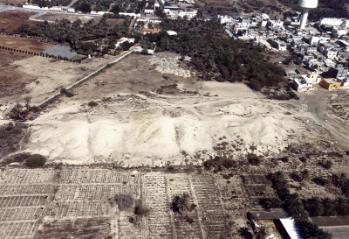Contact Center
.
Jannusan Tylos Necropolis
The sandy mounds of Jannussan are located approximately 900 m to the north of Budaiyah Highway. The site, about 600m long and 50 to 100m wide, gathers three distinct groups (« Mounds » I, II, III), each with several elevations, that spread south of the present Jannusan village, aligned approximately NE/SW. Their surprising height, reaching more than 10m for the highest, differentiates them from the other archaeological tells of Bahrain.
The Jannusan mounds were explored for the first time in the early 1920s by Major C. Daly, then British Political Agent in Bahrain. He notably found in « Mound » IIA a large tomb carefully constructed in well cut and dressed limestone blocks but did not excavate it completely. The French Archaeological Mission reexamined it in 1980 and 1981 and discovered that a warrior wearing iron scaled armour was buried there with several of his weapons (spearheads and arrowheads). Neighbouring stone cists (graves made of flat stone slabs arranged in a rectangular shape) were also found with clay vases and plaster figurines, indicating an early phase of the Tylos culture of Bahrain, probably in the 3rd and 2nd centuries BCE.
“Mound” IIIC, a children’s cemetery composed of many burial jars from the Late Dilmun period (c. 600-500 BCE), was also investigated in 1981. Unique in Bahrain, this cemetery strongly resembles similar Mesopotamian finds from Babylon and Ur in present-day Iraq. In the southwestern end of the same sector, several Tylos graves from the first centuries CE were explored in 1969 by the Direction of Archaeology of Bahrain.
In addition to the numerous burial offerings, a massive limestone capital, decorated in the pure Parthian style, was also found at Jannusan, almost lying on the surface. This unique piece of architecture likely pertained to an ancient Tylos temple, possibly situated in this northern area of Bahrain island.
Archaeological deep soundings and geological studies have clarified the reasons behind the unusual height of these mounds. From an original base level dating to the Early Dilmun period (c. 2000 BCE), a layer of thick sandy deposits accumulated in this sector, likely associated with the regular cleaning of the palm groves and surrounding gardens. This artificially raised area was later used for successive cemeteries in the Late Dilmun and Tylos periods. During this last phase, the building of sand mounds at the top of the graves (a traditional Tylos burial custom) contributed to the final elevation of the Jannusan mounds, which remain a unique component of the archaeological landscape of northern Bahrain.










